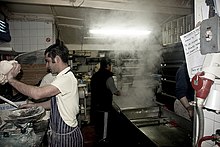Vapors
Vapor is generally the technical term for water vapor that condenses in the air , which then becomes visible as mist . The word steam or vapor is also used in this sense.
In particular, it is also used for cooking or baking steam, which contains not only water vapor but also fats . The term is also used for other combined exhaust gases, such as those that arise in technology when slag is extinguished or that form in ventilation units in gas pipes (see vapors ). Corresponding information can often be found that there is no danger of vapor formation on district heating ventilation boxes from energy supply companies.
In bakery technology, the vapor is added to the baked goods in the oven as a so-called steam . This leads to a more even distribution of heat. The main purpose of the steam is to keep the surface of the baked good soft in the initial phase of the baking process. This enables a better furnace drive. Steam gives the baked goods a shiny surface.
Steam turbines , such as those used in power plants , are also referred to as vapors . In steam turbines, shaft seals (carbon ring seals or labyrinth seals ) are used, through which a residual amount of steam escapes. However, depending on the feed water used , these vapors are only water vapor.
distribution
The word “vapors”, which comes from Low German, is widespread outside of the technical language, especially in northern Germany. The synonymous word “Schwaden”, which comes from the Old High German word “swedan” (swedan (ahd.): Burn, go up in smoke) is more common in southern Germany. It means both a particularly thick haze, such as that emanating from a hot liquid rising into a cold atmosphere, and any thick mist. So it is said in Goethe: "There a steam rises, there swaths." ( Goethe : Faust I, Walpurgis Night ). Another synonymous word, “Brodem” (also Bradem, Broden, ahd. Der brâdam, that is “breath, heat”), on the other hand, is preferably used for the visible, i.e. condensing, steam rising from animals.
See also
Individual evidence
- ↑ Heinrich Büskens: The Back School / Vocational lesson for bakers Volume 1, ISBN 3-7736-2239-2 .
- ↑ As in Theodor Fontane, Der Stechlin, Chapter V: Shortly before eight the old factotum appeared with a silver jug with a lid from which the vapors of hot water rose, (...)

